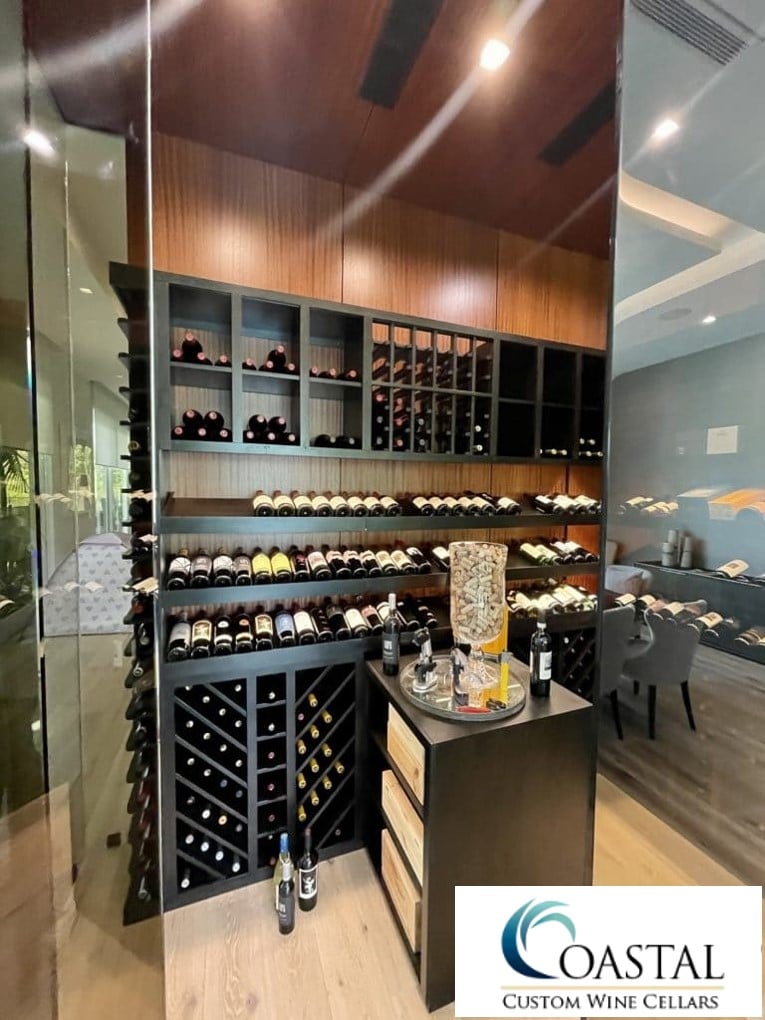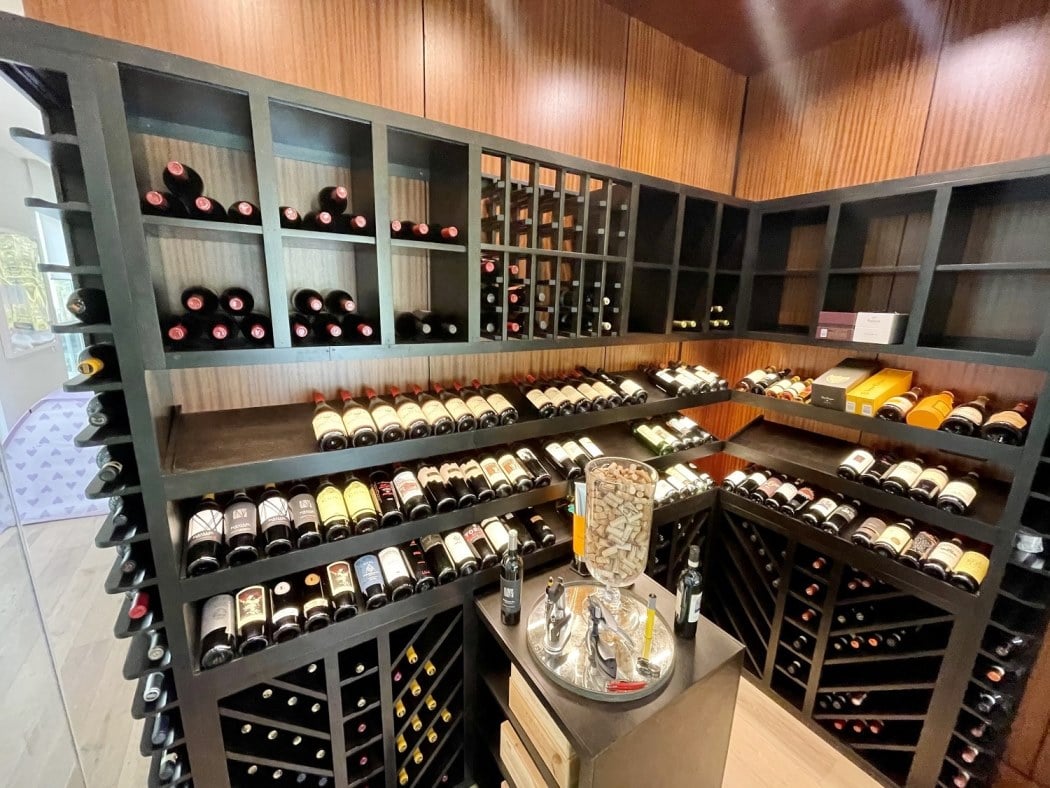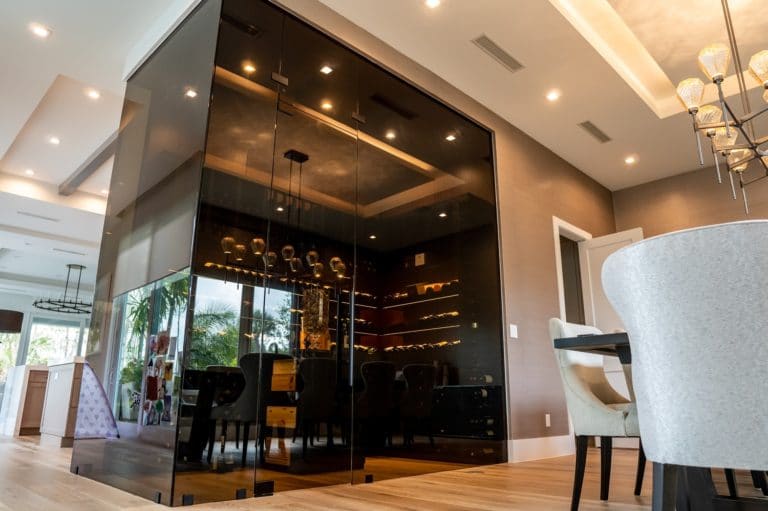Visually Appealing San Diego Transitional Wine Cellar
Coastal Custom Wine Cellars, led by Steve Pantalemon, created a luxurious design for a San Diego transitional wine cellar. The fusion of wood and glass elements helped them achieve the look that complements the existing décor in the client’s home. Read on to learn more about the elegant features of this wine room.
Luxurious Features Incorporated This San Diego Transitional Wine Cellar
A residential glass wine cellar is an excellent addition to a home because it allows easy access to the owner’s favorite vintages while preserving the quality of the wine. The homeowners of a sophisticated home in California sought the help of Coastal Custom Wine Cellars. They needed help building a San Diego transitional wine cellar in their dining room.
The Coastal team built a jaw-dropping wine display and storage area located next to the dining room of the client’s home. The team used their creativity by incorporating features that would bring the wine room to new heights and enhance the experience while dining. Incorporating wood and glass elements together was a perfect idea!
Traditional Features of the San Diego Transitional Wine Cellar: Wood Wine Racks
Wood adds a warm ambiance and vintage feel to any space. It is one of the most widely used materials in making furniture and cabinets because of its many benefits. The timeless appeal, durability, workability, and design flexibility of wood are some of the benefits that make it a favorite material for manufacturing wine racks.
In this wine room installation project, Coastal Custom Wine Cellars installed wood wine racks to create a San Diego transitional wine cellar. They utilized Alder wood and applied a dark stain and lacquer to achieve a richer look. This type of wood is naturally beautiful even when left unstained. It is also known for its high resistance to highly humid conditions in refrigerated wine cellars and excellent durability.
The wood wine racks were placed against a lighter wood panel consisting of grain patterns, creating a beautiful contrast with the dark stain of the racking. The wine display is awe-inspiring, especially when the lights are on.
The Wine Rack Design
Creating a design for a wine rack system requires expertise, time, and creativity in order to make sure that all of the client’s requirements are met. Coastal Custom Wine Cellars has extensive knowledge and passion for providing innovative wine storage solutions.
In this project, the wine room is small, so Steve and his team created a racking design that would maximize the capacity of the space while achieving a sophisticated look. They came up with a unique design for 616 bottles.
They incorporated many shelves for maximum visibility. The wine racks were placed on the back and right walls of the wine cellar, forming an L shape. The racking design created by Coastal is semi-symmetrical, resulting in an organized and clean look.
Both walls consist of cubicles at the topmost section. These cubicles can accommodate individual wine bottles or wines in cases. The only difference between the back wall (longer wall) and the right wall is that it includes individual wine racks and more cubicles than the other wall.
Below the cubicles are three rows of high-reveal displays that pitch the bottles at an angle. A channel was added for the lighting source used to highlight the high-reveal display rows. The bottom section of the walls consists of a single-deep cork-forward rack flanked by diagonal racks on both sides.
Glass Wine Cellar Enclosure
Seamless glass walls and doors are ideally used for adding contemporary features to wine cellars. They also provide a beautiful view of the client’s collection without any obstruction.
In this project, Coastal Custom Wine Cellars built the San Diego transitional wine cellar in a glass enclosure. The custom glass wine cellar is the focal point of the room where the homeowners and their guests can have their favorite meal while enjoying the beautiful display of the wine bottles.
Installing glass components in climate-controlled wine cellars requires expertise because they have an impact on the insulation requirements and the efficiency of the wine cooling system. The more glass elements, the more insulation will be needed to maintain a stable wine storage environment.
Coastal Custom Wine Cellars utilized ¾-inch thermally insulated glass panels on the walls and the door to prevent condensation build-up and mold growth. Mold in the walls and ceiling will affect the structural integrity of your wine cellar. Additionally, mold will ruin the wine labels and grow on the cork and contaminate the wine.
Another benefit of using insulated glass panels is that it helps the wine cooling unit perform with maximum cooling efficiency.
Virtually Quiet and Efficient Wine Cellar Cooling System
One of the reasons many homeowners invest in a refrigerated wine cellar is to preserve the desirable characteristics of their favorite vintages. Wine cooling systems play a crucial role in creating the ideal temperature and humidity level inside the wine room. It is essential to consult an HVAC specialist to ensure proper sizing and installation of the climate control unit.
After performing a heat load calculation, Coastal Custom Wine Cellars decided to install a split-type cooling unit from Wine Guardian. The condensing unit, the noisier component, is located outside the home, offering a virtually quiet operation. The evaporator was placed inside a soffit above the ceiling, so no equipment was visible inside the wine cellar.
Build Your San Diego Transitional Wine Cellar
In this San Diego transitional wine cellar built by Coastal Custom Wine Cellars, the fusion of wood and glass resulted in a visually appealing wine display. The wine racks are designed to maximize storage capacity and create an organized and clean look. The glass walls and door complement the elegance of the home. Overall, the Coastal team did an excellent job!
If you need help with your project, please call us at (858) 429-9190.








